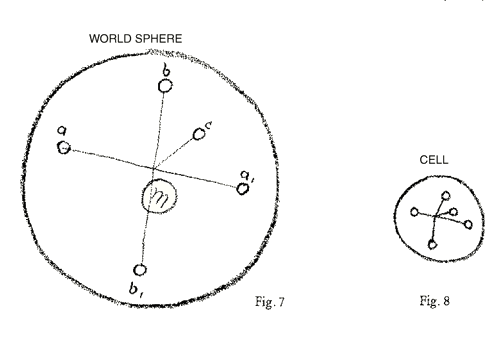
The Redemption of Astronomy:
Toward the Reunion of Natural Science and Social Science
Toward the Reunion of Natural Science and Social Science
Lecture 11 of 18.
Rudolf Steiner, Stuttgart, January 11, 1921:
My dear friends!
We have now gained the most essential premises for a study of some aspects at least of celestial and also of earthly-physical phenomena. In human nature, once again, we have the very significant contrast (to ascertain which, as you will readily understand, we must leave the animal out of account to begin with) — the contrast between the organisation of the head and that of the metabolic system including the limbs. As we have seen, if we wish to relate Man to the Cosmos, we must assign the metabolic system to what is earthly, — what comes to man in a radial direction. Whereas we must assign the forming of the head to all that derives from the great Sphere, — that sends its lines of influence, as it were from the celestial Sphere towards the centre of the Earth, even as the radius reaches outward with its lines of influence to its surroundings. We saw this in the construction of the typical long bones or tubular bones by contrast to the skull-bones, the latter being sphere-like, or like a sector of a sphere.
Envisaging this difference, we must relate it, to begin with, to what appears to us in the relation of the Earth to the Celestial Sphere. You are of course aware, how the scientific consciousness of our time departs from what the naive human being, untouched by any learning, would judge of the appearance of the celestial sphere, the movements of the stars upon it, and so on. We speak of the ‘Apparent aspect’ of the celestial vault. In contrast to it, as you know, we have a picture — a World-picture — gained in a fairly complicated way by interpreting the apparent movements, and so on. Upon this picture — the form of picture which has evolved through the great changes in cosmology since the Copernican era — we are wont to base all our considerations of celestial phenomena.
Today I take it to be generally realised that this World-picture does not represent absolute reality. We can no longer maintain: What is presented to us by this picture, say, as the planetary movements or as the Sun's relation to the Planets, is the true form of the underlying reality, while what the eye beholds is mere appearance. I hardly think any competent person would adopt this standpoint nowadays. Yet he will still have a feeling that he at least gets nearer to a true conception when he proceeds from the apparent picture of the celestial movements — fraught, he will say with illusionary factors (yet after all, we must admit, objectively observed) — to the interpretation of it by mathematical Astronomy.
The question now is, do we really gain a comprehensive view of the phenomena in question if we only base our picture of the World on this, the customary kind of interpretation. As we have seen, when we do so we are in fact only basing it on what the head-man ascertains, so to speak. We base it on the aspect which emerges for man's powers of observation, aided perhaps by optical instruments. But as we saw, for a more comprehensive interpretation of the World-picture we must have recourse to all that is knowable by man, of man. We emphasised how to this end the form of man must be seen in the light of a true science of metamorphosis. Then too we must bring in the evolution of man and of mankind. In a word, concerning the celestial phenomena, or some of them at least, we cannot look for enlightenment till in our efforts to interpret them we go as far as this, calling to our aid whatever can be known of man.
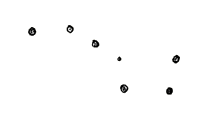
Figure 1
Let us then presuppose what we arrived at in former lectures — the kind of qualitative mathematics, learned from the human form and growth and evolution. With this in the background let us take our start from what meets the eye — from what is said to be the mere appearance of the Heavens — asking ourselves how we may find the way to reality? Let us then ask, dear friends: What does the eye behold, what do we learn empirically, by simple observation? Then we can try to fill in the picture with what is given by the whole structure of man, both in morphology and evolution. First we will ask the question as regards those stars which are commonly described as fixed stars. I shall no doubt be repeating what is well-known to most of you, yet we must call it to mind for only by so doing, only from the facts as seen, taking them all together, shall we be able to advance to the ideas.
Figure 2 | Figure 3 |
What then do we see as to the movement of the fixed stars, so-called? We must consider longer periods of time, since in short periods the Heaven of fixed stars presents practically the same picture year by year. Only when taking longer epochs do we find that it no longer presents the same uniform picture, but that the whole configuration changes. We can envisage it by taking one example; what we shall find in one region of the Heavens would be found in other regions too. Take then this constellation, which you know so well, the “Great Bear” or “Plough” in the Northern sky. Today it looks like this (Fig. 2). Acquaint yourselves with the minute displacements of the so-called fixed stars which have been ascertained, and which agree with what is shown by very ancient star-maps, although the latter are not always reliable. Sum up the minute displacements and calculate what the constellation will have looked like very long ago, and you get this appearance (Fig. 1). You see, the fixed stars, so-called, have undergone considerable displacements. About 50,000 years ago, if we may reckon it from the minute changes observed, the constellation will have looked like this. If we continue to sum up the ascertainable displacements for the future, — assuming, as we surely may do, that they will continue at least approximately in the same direction — we may conclude that 50,000 years from now the constellation will have this appearance (Fig. 3).
Just as this constellation changes in the course of years — for we have only chosen it as an example — so do the others. Thus when we make our drawings, of the Zodiac for instance in its present form, we must be clear that the form of it changes in the course of time — if we may thus include time in our calculations and in interpreting them.
We must therefore regard the celestial sphere as undergoing changes within itself, ever changing its configuration, — changing the aspect of the starry Heavens which we behold in the fixed stars, — though the perpetual change is scarcely perceptible in shorter periods. Naturally, our observations here cannot go very far, nor can we do very much by way of interpretation, though as some of you will know, modern experiments enable us to ascertain even those movements of the stars which are along the line of sight, — towards us or away from us. Yet it remains very difficult to interpret the ever-changing aspect of the starry heavens. In the further course we shall be asking, what human value and significance is to seek in the interpretation.
Having considered the movements of the fixed stars, let us now ask after the movements of the planetary stars. The movement of the planetary stars as we behold it is indeed complicated. The movement we observe is such that if we follow the path of a planet, in so far as it is visible, we see it moving in a curve of peculiar shape — different for the different planets and different too for the same planet at different times. From this we have to take our start. Take for example the planet Mercury. Precisely when it is nearest to us, its path is of peculiar form. In a certain direction it seems to move across the Heavens. Study it daily when visible, we see it moving thus; but them it turns and makes a loop, and then goes on as I am showing (Fig. 4). [[1]] It makes one such loop in a so-called synodical period of revolution. This then we may describe as the movement of Mercury — to begin with at least, so far as observation is concerned. The rest of the path is simple, only at certain places do the loops occur.
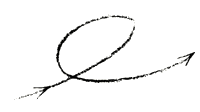 | 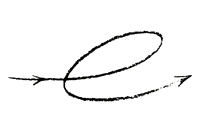 |
Figure 4 | Figure 5 |
Passing to Venus we have a similar phenomenon, though somewhat different in shape and form. Venus moves onward thus, then turns and then moves on, thus (Fig. 5). Here as a rule there is only one loop in the course of a year, and, once again, when the planet — as we conclude from other astronomical data — is nearest to us. Now to Mars: Mars has a similar path, only flatter. We may draw it somewhat like this (Fig. 6). In this case, you see, the loop is more compressed, but the appearance is still that of a loop, — distinctly so. Often however the path (both of this and other planets) is so formed that the loop is completely dissolved, flattened away until it is no more. The path is loop-like, though not an actual loop. (Fig. 7) We will pass by the planetoids, interesting though they are, and look at Jupiter and Saturn. We find them too describing loops or loop-like paths. They again do it when nearest the Earth — and only once a year. As a general rule they make a single loop each year.
 |  |
Figure 6 | Figure 7 |
We have then to consider certain movements on the part of the fixed stars, and the movements of planets. The movements of fixed stars occupy gigantic periods, judged by our standards of time. The movements of the planets comprise a year or fractions of a year and reveal from time to time strange deviations from their ordinary path, loop-lines of movement, in effect. The question now is, what are we to make of these two kinds of movement? How to interpret the loop-movement for example? It is a very big question. Only the following reflection can lead towards any kind of interpretation of the loop-movements.
In all our human observation the fact is that we are quite differently related to our own conditions and to those things which are not our own; — which take place apart from us, outside us, so to speak. You need only recall how it is with objects: The enormous difference between your relation to any object of the so-called outer world and to an object inside yourself, which you, so to speak, are sharing-in with your own inner experience. If you have any object before you, you see it, you observe it. What you yourself are living in — your liver, your heart, even your sense-organs to begin with you can observe. There is the same contrast, though not quite so strongly marked, with regard to the conditions in which we are living in the outer world. If we ourselves are in movement and if it is possible for us to remain unconscious of how we bring about the movement, then we may well be unaware of our own movement and therefore leave it out of account in judging outer movements. That is to say, though we ourselves are in movement, we leave this out; we deem ourselves at rest and envisage only the external movement.
It is on this reflection, in the main, that the interpretation of movements amid the celestial phenomena has been based. You are aware, it has been argued: Man, at a certain point on Earth, shares of course in the spatial movement of his earthly habitation (eg the circling movement of his latitude) but knows it not and hence regards, what he sees happening in the Universe outside him, as a real movement in the opposite direction. The argument has been abundantly made use of! The question now is: How might this principle be modified if we take into account that in man's organized (if I may so express it) radially, whilst in our head-man we are oriented spherically. If it were then a fundamental feature of our own state of movement that we relate ourselves differently to the Radius and to the encompassing Sphere, this fact would somehow make itself felt in what appears to us in the outer Universe.
Imagine what I have said to be in some way true. Suppose for instance that you yourself were moving thus (Fig. 8), — you were describing a Lemniscate. Let us assume however that the Lemniscate you were describing was not exactly like this, but that by variation of the constants the form of Lemniscate were brought about in which the lower branch did not close (Fig. 9). Assume then that a Lemniscate arises which by a certain variation of the constants is open on one side. The curve is mathematically feasible, and if you find the right way, you can certainly draw it into the human form and figure.
Figure 8 | Figure 9 |
Say now that this were the surface of the Earth (Fig. 10). We should have to draw, somehow in relation to the Earth, what passes through our limb-nature and then in some way turns, goes through our head-nature and then back again into the Earth. Say you could truly draw into the nature and organisation of man such an open Lemniscate; we should be justified in saying: There is an open Lemniscate of this kind in man's nature. The question is, is it of real significance to speak of such an open Lemniscate in human nature? It is indeed. You need only make a deeper morphological study; you will find the Lemniscate, either in this or in some modified form, in diverse ways inscribed in human nature. These things have not been gone into with due method. I advise you, try it. (As I said, we are only giving indications for further work; diligent research is needed.) Try it; investigate the curve that arises if you trace the middle line of a left-hand rib, then go past the junction into the vertebra, then turn and go back along the right rib (Fig. 11). Bear in mind what it must signify that as you go along this line — rib-vertebra-rib — various inner relationships of growth must play their part, not only quantitatively but qualitatively; then you will find in the Lemniscate with its loop-formation a morphological key to the whole system. Going upward from thence to the head-organisation, the farther you go upward, the more will you find it necessary to modify the form of Lemniscate. At a certain point you must imagine it transformed; the transformation is already indicated in the forming of the sternum, where the two come together. When you get up into the head there is a far-reaching metamorphosis of the lemniscatory principle. Study the whole human figure — the contrast above all of the nerves-and-senses organisation and the metabolic, — you get a Lemniscate tending to open out as you go downward and to close as you go upward. You also get Lemniscates — though highly modified, with the one loop extremely small — if you follow up the pathway of the centripetal nerves, through the nerve-centre and outward again to the termination of the centrifugal nerve. Follow it all in the right way: Again and again you will find this Lemniscate inscribed in man's nature, — man's above all. Then take the animal organisation with its manifestly horizontal spine. You will find it differing from the human, in that the Lemniscates, whether the downward loop be open or closed to some extent, are far less modified, less varied than they are in man. Moreover in the animal their planes are more parallel, whereas in man they are variedly inclined and askew to one another.
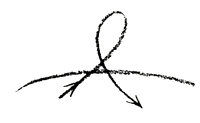 | 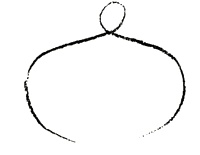 |
Figure 10 | Figure 11 |
It is an immense and very promising field of work, — this ever-deepening elaboration of morphological study. And as you apprehend these tasks, you will appreciate the outlook of such men — of whom there have always been a few — as Moritz Benedikt for instance, whom I have mentioned before. Benedikt had many fruitful thoughts and good ideas. As you may read in his memoirs, he regretted how little possibility there is of speaking to doctors of medicine from a mathematical standpoint or with the help of mathematical notions. In principle he is quite right, only we have to go still farther. Ordinary mathematics, reckoning in the main on rigid forms of curve in a rigid Euclidean space, would help us little if we tried applying it to organic forms. Only by seeking, as it were, to carry life itself into the realms of mathematics and geometry as such, by thinking of the independent and the dependent variable in an equation as being subject to an organic and inherent variation, as illustrated yesterday for the Cassini curves (Variability of the first and of the second order), only thus shall we make progress. But if you do this immense possibilities will be opened up. It is indeed already indicated in the principles applied when constructing cardioid or cycloid curves; you must only not fall back again into rigidity of treatment.
Apply this principle — the inner mobility, as it were, of movement in itself — to Nature. Try to express in equations, this that ‘moves the moving’. You will then find it possible, mathematically to penetrate what is organic. You will come to say, for it can well be formulated thus: The axioms of rigid space — space immobile in itself — lead to an understanding of inorganic Nature. Conceive a space that is inherently mobile — or algebraic equations whose very functionality is in itself a function — and you will find the transition to a mathematical understanding of organic Nature. This incidentally is the method which should accompany the efforts now being made to investigate the transition-forms from inorganic Nature to organic, as regards shape and form at least. Valueless apart from this, they have a future if this method be applied.
Take now the presence of the loop-making tendency in the human body and compare it with what confronts us, admittedly in a more irrational form, in the forms of movement of the planets. You will then realise: The 'apparent movements’ of the planets, as we are wont to call them, in a most striking way inscribe, in forms of Movement in the Heavens, what in the human body is a Form as such — a characteristic, fundamental figure. Therefore, to say the least, we must in some way correlate this basic form in the human body and these phenomena in the Heavens. And we shall now be able to say: Behold the loop. It always appears when the planet is relatively near the Earth, — therefore when we, being on the Earth, are in a special relation to the planet. Consider the position of the Earth in its yearly course and our position on the Earth. (We must refer it back to our own formative period, the embryo-period of our life, needless to say.) Consider in effect how we are alternating between a position relative to the planet wherein we turn our head towards the planetary loop and a position where we take leave of the loop and at length turn our head away from it. We in our process of formation are thus related to the planet: We are exposed at one time to the planet's loop and at another to the remainder of its path. We can therefore relate, what lies nearer to our head, to the loop, and what belongs more to the remainder of our body, to the planetary path outside the loop.
Take in addition what I said before, I said, with regard to the morphological relation of the tubular or long bone to the skull-bone: Try how you would have to draw it. Here, throughout the long bone, is the radius; then as you pass to the skull-bone you will have to turn, like this (Fig. 12). Project this turn, in relation also to the Earth's movement, outward into the Heavens. It is the loop and the rest of the planet's path! If we develop a feeling for morphology in the higher sense, we can do no other than assign the human form and figure to the planetary system.
Fig. 12
And now the movement of the fixed stars themselves: — The movements of the fixed stars will naturally be less concerned with the several movements of individual human beings. Think on the other hand of the whole evolution of mankind on Earth. Bear in mind all we have said in these days of the relation of the great Sphere to the human head-formation. You cannot but divine that there will be some relation between the metamorphoses of aspect of the starry Heavens, and of the evolution of mankind in soul and spirit. There is the vault of the great Sphere above us. It reveals only that part of the movements which would correspond to the loop among the planets (nay more, as it would seem, only to part of the loop; Fig. 13, dotted line). In the movements of fixed stars, the rest of the path is omitted. Our attention is drawn to this great differentiation: The planets must somehow correspond to the whole man; the fixed stars only to what forms the head of man. Now we begin to get some guidance, how to interpret the loop.
Fig. 13
We human beings are in some way with the Earth. We are at some point on Earth and we move with it. We cannot but refer, what appears to us in projection on the vault of heaven, to the movements we ourselves are making with the Earth. For, as we move with the Earth (we ,must project this backward, once more, backward in time to the embryo-period of our life), — as we move with the Earth, what we have in us comes into being, formed as indeed it is by the very forces of movement. In the movements we see up yonder in their seeming forms and pictures, we have to recognise the cosmic movements we ourselves are making in the year's course. We realise it as we approach the true aspect of the loop-curve. (Downward of course we always see the loop still open. In the immediate aspect, it does not close at all. Looking at this alone, we should never get a complete path. We only get the complete path when contemplating the entire revolution.)
I am relating all this rather quickly. You must reflect on it in detail and try to see the different things together. The more minutely and scrupulously you do so, the more will you find that the planetary movements are, to begin with, images — images of — movements you yourself accomplish, with the Earth, in the year's course. (We shall see in time, how a synthesis arises from the different planetary movements.)
If then we see the human being as a whole and his projection to the Cosmos, we are led to recognise that the true form of movement of the Earth in the year's course will be the loop-curve or Lemniscate. We shall have to study it more closely during the next few days, but at this stage we are already led to conceive the path of the Earth itself as a loop-curve — quite apart now from its relation to the Sun or any other factor. What is projected then, for our perception, the planetary paths with the loops they make, — we must regard as the projection by the planets of the loop-path of the Earth on to the vault of Heaven, if we may formulate thus simply a very complicated set of facts. As to why, when the planet draws near the loop, we have to leave the rest of the path open during a relatively short space of time, — the reason lies in the fact that under certain conditions the projection of a closed curve may appear open. For example, if you were to make a Lemniscate, say of a flexible rod, and project the shadow of it on to a plane, you could easily make it so that the projection of the lower part appeared divergent and unclosed, whilst the upper part alone was closed; so the entire projection would become not unlike a planetary path. Quite simply in the shadow-figure, you could construct the likeness of a planet's path.
Notes:
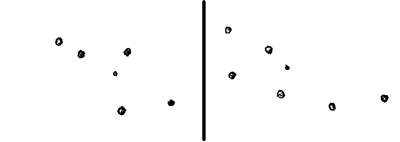
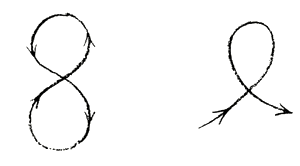





No comments:
Post a Comment